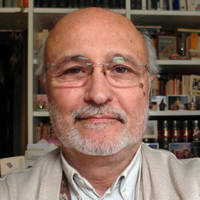
Introducing Fabrizio Eva
Fabrizio Eva (Carrara, 1949) is professor on contract in Political and Economic Geography at the University of Cà Foscari Venice, Treviso Campus.
He is specialised in East Asia, dynamic geopolitics and geopolitical crisis. Professor Eva holds a degree in Italian Modern Literature, specialization Geography and History.
As an appetizer, a key observation in “Geopolitics of Kurdistan: A Telling Example of the Territorial Trap”:
The big stick is still the main instrument in Geopolitics.
Dr Leonhardt van Efferink founded ExploringGeopolitics in 2009. Since then, the website has published over 200 contributions by more than 130 scholars. To celebrate its 10-year anniversary, ExploringGeopolitics has invited its contributors to reflect on geopolitical trends in the 21st century. Two questions play a central role. What was the main trend in the 2010s? And what will be the most important trend in the 2020s?
Rojava in North-East of Syria is an autonomous federation that has been practicing the “libertarian municipalism.”
The ambiguity of the ‘nation-state’ concept is challenged by two (f)actors. The first one is the Kurdish Democratic Confederalism proposal, published in 2011 by the jailed Kurdish PKK leader Abdullah Őcalan along the ideas of the anarchist Murray Bookchin. The second one concerns the everyday experiences of Rojava in the North-East of Syria. This is an autonomous federation that has been practicing the “libertarian municipalism” (Bookchin, 1986, 1995) since about 2014 in a situation of armed conflict.
In comparison with the ideological and/or conceptual challenges of the past, the current Kurdish proposal does not to want to change the existing borders.
In comparison with the ideological and/or conceptual challenges of the past, the current Kurdish proposal does not to want to change the existing borders. Instead, it seeks to self-organize the society and the economy with a bottom-up approach. This approach involves a flexible institutional structure which starts from the municipalities. The aim is to change the everyday life in the society, thereby changing the traditional meanings of “political border”.
the decision makers in power are incapable to conceive a (self-organized) society outside the institutional cage of the state.
The main arguments against this proposal are related to two major mental and iconographic cages (drawing on Jean Gottmann). First, the decision makers in power are incapable to conceive a (self-organized) society outside the institutional cage of the state. We can call this the “legacy of the state.” It assumes that the fixed borders are conceived as the only grant for a peaceful world, even if the geopolitical praxis shows how wrong this assumption is.
Not a single state in the world is made up of one unique “nation.”
Second, each state is conceived as an obvious and “natural” aspiration of any “nation”. However, not a single state in the world is made up of one unique “nation”.
So the geopolitical dynamics and crises are managed by the leaders of a maximum of 10 governments. These are the five veto right-holding states in the UN Security Council plus a variable number of states surrounding the geopolitical crisis area. The involved leaders are stuck in John Agnew’s territorial trap (i.e. the state as the unique geopolitical criterion). This trap refers to the legacy of the state, the obsession of untouchable borders and the economic interests of their constituencies. As a result, the big stick is still the main instrument in Geopolitics.
